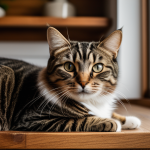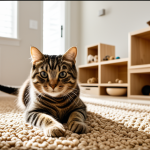Overview of Polycystic Kidney Disease in Cats
Polycystic Kidney Disease (PKD) in cats is a genetic disorder that primarily affects the Persian breed and other related species. It is characterised by the development of multiple fluid-filled cysts within the kidneys, leading to progressive loss of kidney function over time. This condition can significantly impact a cat’s kidney health, causing a range of symptoms and requiring attentive care.
Definition and Causes of PKD in Cats
PKD in cats is caused by an inherited genetic mutation. The disorder is autosomal dominant, meaning a cat only needs one copy of the mutated gene to be affected. These kidney cysts are often present from birth and gradually increase in size, disrupting normal kidney tissue and function as the cat ages.
Sujet a lire : Ultimate Handbook for Creating an Engaging Play Area for Blind Cats
Symptoms and Diagnosis of PKD
Common symptoms of PKD include increased thirst and urination, loss of appetite, weight loss, and lethargy. Diagnosis typically involves imaging techniques such as ultrasound, which can detect cysts even in young cats. Blood and urine tests may also be used to assess overall kidney function.
Impact on Feline Health and Quality of Life
PKD can lead to chronic kidney disease, which profoundly affects a cat’s quality of life. Early detection and management are crucial in mitigating the negative effects on kidney health and extending the feline’s lifespan.
Sujet a lire : Designing a Comfortable Sanctuary: The Ultimate Guide to Senior Cat-Friendly Homes
Dietary Strategies for Managing PKD
Polycystic Kidney Disease in cats necessitates thoughtful dietary strategies to ensure optimal feline nutrition. A focus on kidney-friendly foods can be crucial in managing this condition effectively.
Importance of Nutrition in PKD Management
Innovative diet plans are pivotal in supporting kidney health. By reducing protein, phosphorus, and sodium intake, owners can alleviate strain on the kidneys. Such changes can help maintain electrolyte balance and lower blood pressure, preserving kidney function.
Key Nutrients and Ingredients
Key ingredients in a PKD-friendly diet include:
- Omega-3 fatty acids, which possess anti-inflammatory properties
- High-quality proteins in limited quantities
- B-vitamins to support metabolism
These nutrients can slow disease progression and elevate overall well-being.
Recommended Dietary Plans
Sample meal plans often incorporate commercial kidney diets, specially formulated for PKD. These products balance essential nutrients and limit harmful elements. Consult a veterinarian for personalised meal recommendations, ensuring they meet individual dietary needs without compromising on essential nutrients.
Medication Approaches for PKD
Polycystic Kidney Disease (PKD) in cats presents unique challenges, and medication strategies play a crucial role in managing this condition. While there is no definitive cure for PKD, certain medications can help manage symptoms, thereby improving the feline’s overall quality of life.
Overview of Medications for PKD
Often, PKD treatment involves medications that address high blood pressure and manage discomfort. Angiotensin-converting enzyme (ACE) inhibitors are commonly prescribed to manage hypertension, a frequent complication of PKD. Additionally, pain relief medications like non-steroidal anti-inflammatory drugs (NSAIDs) may be prescribed cautiously under strict veterinary guidance due to potential kidney-related side effects.
Managing Symptoms with Medication
Effective symptom management through pharmacology can significantly alleviate symptoms and provide relief. For instance, phosphorus binders can be administered to control elevated blood phosphorus levels, while appetite stimulants might be necessary for maintaining adequate feline nutrition.
Alternative and Complementary Therapies
In conjunction with conventional medications, veterinary care may encompass integrative approaches such as acupuncture and herbal treatments. These therapies aim to enhance treatment outcomes, though they should be pursued only with veterinary approval. Regular monitoring ensures treatment efficiency and safety.
Monitoring and Managing PKD Progression
Polycystic Kidney Disease (PKD) requires diligent monitoring to effectively manage its progression in cats. Consistent evaluation is critical, making regular veterinary check-ups indispensable. These check-ups not only assess the current state of the disease but also adjust treatments as needed. Veterinarians provide insights into both symptom evolution and disease management strategies.
Importance of Regular Veterinary Check-Ups
Through collaboration with a veterinarian, cat owners can navigate the complexities of PKD with confidence. Routine check-ups help identify changes early, allowing for timely intervention. A proactive approach ensures alterations in kidney function or symptoms are addressed promptly.
Identifying Changes in Symptoms or Behavior
Recognising subtle changes in your cat’s health is crucial; alterations in appetite, urination, or energy levels may indicate disease progression. Owners should track these observations and report them to their veterinarian. This information is vital for adjusting PKD management strategies effectively.
Home Monitoring Techniques
For concerned pet owners, home monitoring techniques are invaluable. Keeping a daily log of behaviour, hydration, and eating patterns helps identify trends that necessitate professional attention. Simple, consistent records complement professional veterinarian collaboration, enhancing the overall management plan.
Case Studies and Expert Insights
Case studies provide invaluable examples of how Polycystic Kidney Disease (PKD) impacts cats and illustrates tailored management strategies. In one notable case, a Persian cat diagnosed with PKD early on demonstrated improved kidney health through a combined regimen of medication, diet, and vigilant monitoring. Regular veterinary care allowed for adjustments in treatment, highlighting the importance of collaboration between pet owners and professionals.
Veterinarians offer critical insights into managing PKD agilely. Dr. Jane Mitchell notes that early intervention can significantly slow disease progression, particularly when innovative diet plans are integrated with the prescribed medications. She emphasizes that understanding each cat’s unique needs ensures more effective intervention.
Lessons learned from these cases underscore the multifaceted approach necessary for managing PKD in cats. A keen eye on symptom changes, coupled with adherence to tailored treatment regimens, proved to maintain quality of life substantially. The analytical breakdown of treatment outcomes repeatedly shows that attention to detail, patient-specific strategies, and expert recommendations are paramount in successfully navigating PKD challenges. Real-life experiences reaffirm that well-rounded PKD management strategies are crucial.
FAQs about Polycystic Kidney Disease in Cats
Providing answers to Common Concerns is essential in guiding pet owners through the complexities of Polycystic Kidney Disease (PKD). Understanding these concerns helps in better managing their feline’s condition.
Frequently Asked Questions
A common query is: “Can PKD be prevented?” No, it can’t be prevented, as PKD is a genetic disorder. It’s crucial for breeders and potential cat owners to know this and perform genetic testing for early detection.
Another frequent question: “How is PKD treated?” While no cure exists, management focuses on symptomatic relief and slowing progression through diet and medication.
Misconceptions about PKD
A prevalent misconception is that PKD only affects older cats. In reality, cysts are present from birth but may not manifest symptoms until later. Thus, early veterinary intervention and regular screenings can aid in timely management.
Resources for Further Reading
For a thorough understanding of PKD, it is advised to consult veterinary care guides and scientific journals. Engaging with reputable resources can offer deeper insights, equipping owners with the knowledge to manage PKD effectively.









